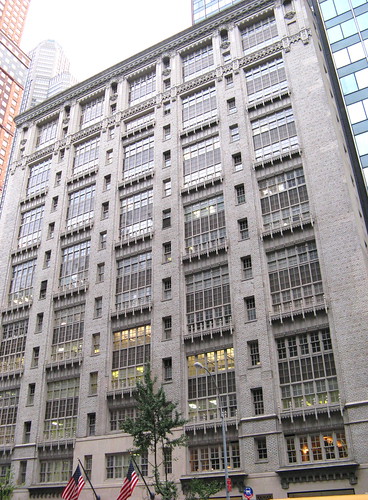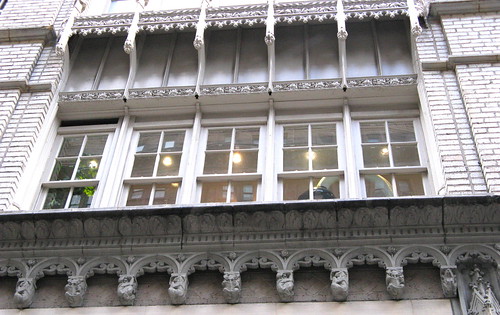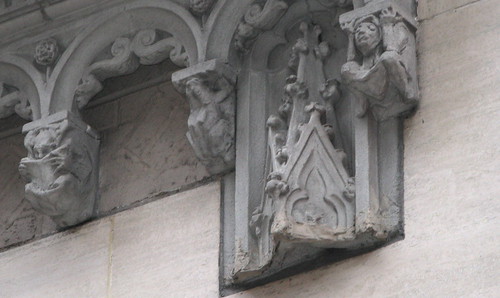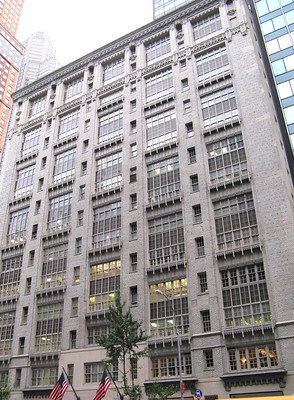f the artists who developed the Rodin Studios building on New York City’s West 57th Street or the architect who designed it had favorites among the structure’s terra cotta characters, we may never know. Was it the frog, the man reading his book, or the ancient character holding a palette? We do know that nearly a century after the building’s construction in 1916-1917 and long after the people who created the structure are gone, these figures remain. They silently gaze above the passersby today, witnesses to a time when this section of Manhattan was an artists’ mecca. Do many people stop to really look up at and appreciate these decorative terra cotta figures, I wonder?
Terra cotta is the material of a thousand different characters. The term terra cotta comes from the Italian words meaning “baked earth.” It’s made from a mixture of fine-grained clays, chosen for their particular qualities, that is fired in a kiln. It can be molded into something tiny and delicate or massive. Sometimes this material is formal, regal, and showy. Other times, it’s made into figures that are playful and inviting, or grotesque and scary. Buildings become quite personal and animated due to its flourishes, shadows, and expressions.
All of this is evident in the Rodin Studios, located at 200 West 57th St., at the southwest corner of Seventh Avenue. The structure has a splendid mix of fanciful mythic figures and cathedral-style motifs. A number of buildings constructed in the late 19th and early 20th centuries in this part of Manhattan show why New York is a terra cotta lover’s paradise. These include the Alwyn Court apartments at 182 West 58th St., and the Church for All Nations, the former Catholic Apostolic Church, at 417-419 West 57th St. (See “Terra Cotta Tales: Alwyn Court” and “Terra Cotta Tales: Catholic Apostolic Church” on Mindfulwalker.com.)
The Rodin Studios, a designated New York City landmark, is a building that several artists – organized together into a company – created as a functional and elegant residence for other artists. Here, they could have living quarters and studios in one space. Their quest for living space resulted in a fine piece of art left for the ages.
Midtown Manhattan is probably known more for its raging commercialism today, but this building was much about art, artists, and especially about fervor for France. The three key artists behind its construction were painters who had received training or taught in France, and who were influenced by French art: Lawton Parker, and Georgia Timken Fry and husband John Hemming Fry. Parker was a member of a group of American artists in Paris, called The Giverny Group, who were devotees of Claude Monet, according to records of the New York City Landmarks Preservation Commission (LPC). Another sign of their love for art and France: The artists decided to name their new building after renowned sculptor Auguste Rodin, a Frenchman.
The artists had lofty aims when they picked the building’s architect, too. They chose Cass Gilbert, who had recently completed the neo-Gothic Woolworth Building on Lower Broadway, the “cathedral for commerce,” in 1913. It was the world’s tallest building at the time.
Gilbert was “known to be sympathetic to artists” and thought of himself as an artist, as the LPC records explain. Though not trained at France’s École des Beaux Arts, Gilbert admired the school’s principles. The images of Europe’s grand buildings had been ingrained in him since his younger days when Gilbert sketched the architectural features of buildings while traveling in France, Italy, and England.
“A Shimmering Cascade”
Sometimes a building can seem to be solid and flowing in the same instant: This is one example. It has the solidity of variegated brickwork, primarily buff-colored and somewhat earthy in texture. The flow comes in its patterns of ornament: terra cotta and cast and wrought iron in French Gothic and neo-classical motifs that seem to spill over from top to button. As the New York Times’ Christopher Gray wrote of the effect in a 2006 article, “It’s a shimmering cascade of French Gothic ornament running down the 57th Street façade like a sheet of water.”
This isn’t just a building to stand back from across the street and admire. When I look at the Rodin Studios building closely, I consider the variation in Gilbert’s Woolworth Building, its reverence and irreverence: the soaring cathedral-like spires and arches of the exterior and yet the caricatures of Woolworth counting dimes, Gilbert, and others in the lobby. Obviously, Gilbert wanted people to not only admire but be engaged, even entertained, by buildings.
The Rodin Studios has some of this same variation in character. Observe it from a distance and it seems like a gracious, staid – some might even say boring – building. But get close up and its personality comes alive, especially in the terra cotta details on both the West 57th Street and Seventh Avenue facades. First, there’s the rich ornamentation of the classical motifs and Gothic tracery: fluted moldings, finials, archways, curving foliage, those shapes and textures that make one think of wedding cake sculpting – except that it’s a building!
Other terra cotta elements give the Rodin Studios a special aliveness, many human and animal forms that almost make it seem the building is going to speak, laugh, cry, or even howl. At the lower-story level on 57th Street, a series of antic figures supports a string of arches: a reader seemingly lost in his book, a frog, a sky gazer, a figure facing the front who is holding his arms up to support an arch, and one in profile carrying the arch’s weight. On the Seventh Avenue side, a grotesque figure stares out.
Grins and Grimaces
Many of the Rodin Studios’ other terra cotta figures aren’t easily discernible from the street, since they are part of the 14-story building’s cap. But good binoculars bring them in sight. The top repeats the pattern of corbel arches, with different figures: one hooded, another wearing a head band, and one looking rather pouty. At the top of flattened columns are other mysterious and amazing figures: The LPC landmark record describes them as ancients, and one is grinning and holding a palette while the other is distraught. Griffins sit atop some of the pilasters, those dynamic mythical animals that combine eagle and lion.
The building’s details are like an unfolding story: It can take repeat visits to know and enjoy this place, and to understand its various lives. In the mid-20th century, the owner converted the Rodin Studios into an office building and “floored through” its artists’ studios, the New York Times reported. What we see in the building’s character and ornament today would not have survived if not for those who came before us and cared about this structure. The Landmarks Preservation Commission, for one, designated the Rodin Studios a landmark in 1988. The building is now owned by The Feil Organization. In 2006-2007, the building owners initiated a full restoration at a cost of more than $2 million, according to the Times.
The word “painstaking” doesn’t do justice to the restoration effort. For example, the owners replaced 400 pieces of failed terra cotta with matching cast stone elements. Those working on the restoration dismantled and rebuilt six terra cotta balconies, and repaired or replaced 175 pieces of cast iron. The project drew awards, including an AIA New York State Award of Merit for Historic Preservation. Architect Carlo Zaskorski, of the firm Zaskorski & Notaro that worked on the exterior restoration, told the Times of the intricacy involved in resuscitating the terra cotta: As Gray wrote, “Mr. Zaskorski contends that you have to lay your hand on every piece to feel for any deterioration. `There’s a lot of Zen in this,’ he said.”
Little surprise, then, that the Rodin Studios rewards our meditative observation with wonder.
View the slide show at Flickr.
To complete a walking tour of buildings with wonderful terra cotta ornamentation in close proximity in Midtown Manhattan, also see:
Terra Cotta Tales: Alwyn Court
Terra Cotta Tales: Catholic Apostolic Church







No Comments so far ↓
There are no comments yet...Kick things off by filling out the form below.